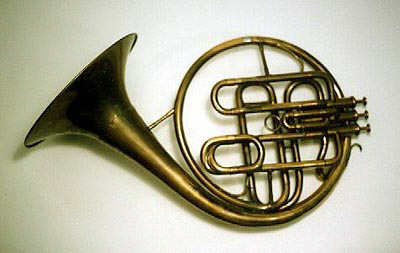|
Label:
|
F. VAN CAUWELAERT
BREVETÉ BRUXELLES |
|
Model:
|
single, with terminal crooks, "Gantois" |
|
Serial Number:
|
none |
|
Date of Manufacture:
|
ca. 1890 |
|
Key(s):
|
F (other terminal crooks as available) |
|
Valves:
|
3 Périnet piston |
|
Bore:
|
10.6 mm |
|
Bell Flare:
|
original gusset, replaced with spun flare |
|
Bell Throat:
|
approx. 8 cm. |
|
Bell Diameter:
|
24.4 cm. |
|
Base Metal:
|
brass |
|
Finish:
|
raw brass |

|

|
The Van Cauwelaert family of brass wind instrument makers flourished in Brussels from 1846 to about 1955, although the exact relationship among the several generations is not known. Ferdinand-Joseph Van Cauwelaert (1808-1884) established his brass instrument workshop in Brussells 1846. |
|
|
|

Ferdinand Van Cauwelaert |

Maison Van Cauwelaert, ca. 1900 (click to enlarge) The Van Cauwelaert horns were certainly the most popular choice among Belgian horn players for over seventy-five years, during the second half of the nineteenth century into the 1930s. This is the "Gantois" model, so called by Edmond Leloir, because of its popularity among players in Ghent. It requires a terminal crook which distinguishes it from the fixed leadpipe model used in Liège. The horn has several expert repair patches and the valves are well worn, probably indicating that its owner used it extensively and regarded it worth continued maintenance. The original gussett bell flare has been replaced by a spun flare(see below). The original set of crooks has been lost; the F terminal crook shown above right is a reproduction by Richard Seraphinoff. The valve slides can probably be used with crooks pitched from at least D to A. The three Périnet piston valves are sprung from the bottom. The valve tops ("buttons") are also restoration replacements by Richard Seraphinoff. This horn plays beautifully and has a very light sweet tone, characteristic of the small-bore french design. |
|

|

|

The original label is on the the bell tail. Early labels were engraved in script. Typeset labels were introduced in the late 1880s by the "frères and soeurs" after the death of their father, Ferdinand. The original gussett bell flare has been replaced by a spun flare which is crudely engraved "Mathieux Alargale", possibly either the name of the repair person a previous owner of the horn. |

|

The dapper anonymous player shown above is apparently very proud of mastering a difficult etude on his Van Cauwelaert Gantois horn. This model was also popular in military bands (see right). |

Image courtesy of Pierre Dubar (click to enlarge> |